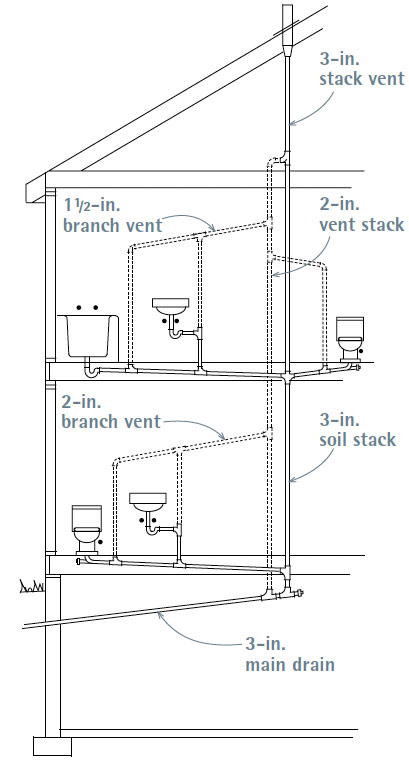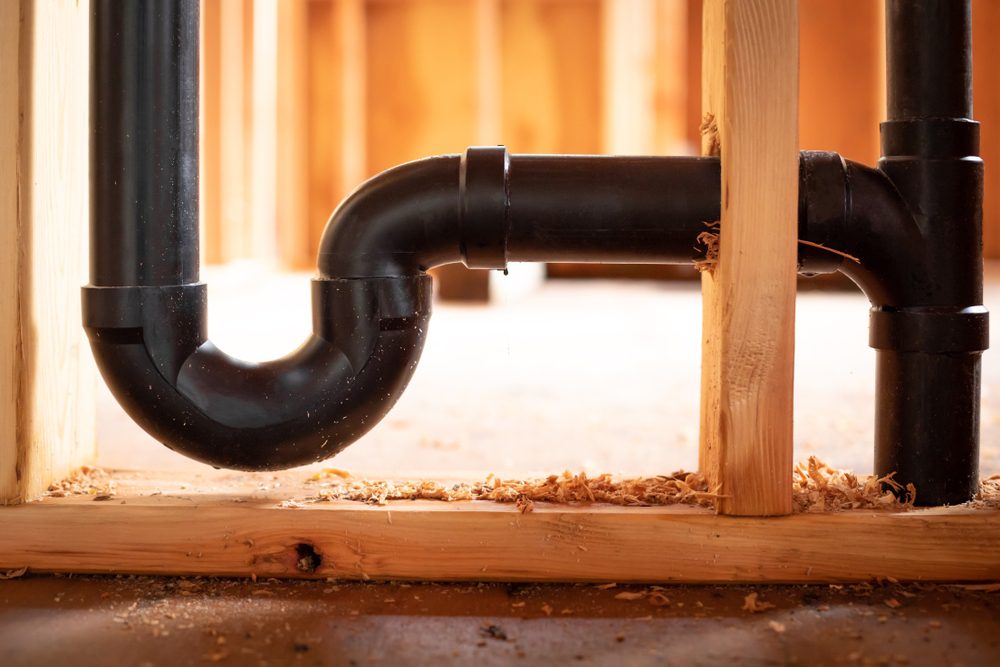This great article following next involving Essential Plumbing Vent Pipes: Understanding Their Role is particularly entertaining. Don't overlook it.

Appropriate air flow in plumbing systems is usually overlooked, yet it is essential for preserving the performance and safety and security of your home's pipes. Ventilation helps manage air pressure, avoid the buildup of hazardous gases, and ensure the reliable elimination of waste. In this overview, we will certainly check out the relevance of appropriate plumbing air flow, how it works, and the advantages it brings to your pipes system.
Exactly How Ventilation Functions in Plumbing Solutions
Atmospheric Pressure Guideline
Proper air flow keeps balanced atmospheric pressure within the pipes system. When water flows through pipelines, it displaces air. Without adequate ventilation, this variation can develop adverse stress, bring about slow drains or siphoning of water from traps, which can cause unpleasant odors to seep right into the home.
Avoiding Sewage System Gas Buildup
Among the most essential features of pipes vents is to stop drain gases, such as methane and hydrogen sulfide, from building up within the home. These gases can position serious health risks and are extremely combustible. Vent pipelines allow these gases to escape securely outside.
Aiding in Waste Removal
Ventilation aids in the efficient removal of wastewater by avoiding airlocks in the drainage system. When air can move easily through the vents, it allows water and waste to move efficiently with the pipes, decreasing the threat of blockages and back-ups.
Advantages of Correct Air Flow
Enhanced System Performance
Effectively ventilated pipes systems operate much more efficiently, with fewer clogs, faster draining pipes, and less stress on the pipelines. This effectiveness expands the lifespan of the plumbing system.
Improved Air High Quality
By avoiding sewer gases from entering your home, correct air flow adds to much better indoor air quality, making your living environment healthier and much more comfortable.
Avoiding Water Damage
Ample air flow assists avoid water from being siphoned out of catches, which can lead to drain gases going into the home and triggering water damages over time.
Actions to Ensure Proper Ventilation
Consulting Plumbing Codes
Always seek advice from neighborhood plumbing codes when designing or changing your plumbing system. These codes supply the essential guidelines for proper venting and guarantee your system meets safety and security requirements.
Routine Examination and Maintenance
Normal inspections can assist determine prospective ventilation issues before they become major issues. Maintenance jobs, such as cleaning air vent pipelines and looking for blockages, are vital for maintaining the system in good working order.
Professional Installment
For new installments or major modifications, it's important to employ a specialist plumber. They have the competence to make certain the ventilation system is properly developed and set up according to code.
Recognizing Ventilation in Plumbing
Air flow in plumbing describes the network of pipes that permit air to stream through the drainage system. These vents serve several functions, including controling air pressure within the pipelines, protecting against drain gases from going into the home, and helping in the smooth circulation of wastewater.
Types of Plumbing Vents
Main Heap Vent
The main pile vent, also called the air vent pile, is the key vent in a pipes system. It extends from the major drainpipe line up through the roof, enabling gases to get away and fresh air to go into the system.
Branch Vent
Branch vents attach to the major pile vent and offer individual components, such as sinks, commodes, and showers. These vents make sure that each component has appropriate ventilation to function appropriately.
Air Admittance Shutoff (AAV).
An Air Admission Shutoff (AAV) is a one-way valve that allows air to go into the pipes system without the requirement for a typical vent pipeline extending with the roof. AAVs are commonly made use of in improvements or locations where setting up a common air vent is impractical.
Indications of Poor Ventilation in Plumbing.
Slow Draining Fixtures.
If your sinks, bathtubs, or bathrooms are draining pipes slowly, it could be a sign of poor ventilation. Poor air circulation can produce a vacuum cleaner result, making it hard for water to drain pipes effectively.
Gurgling Seems.
Gurgling sounds originating from drains are frequently an outcome of air being drawn through water catches because of negative pressure in the pipes. This is a clear indicator of not enough ventilation.
Unpleasant Odors.
Sewage system smells inside your home are a warning that your pipes system is not appropriately aerated. This can suggest that drain gases are not being sufficiently aired vent outside, bring about possibly hazardous conditions.
Common Ventilation Mistakes.
Poor Vent Sizing.
Utilizing small vent pipelines can cause bad air circulation and pressure inequalities in the system. It's important to utilize vents that satisfy the details needs of your pipes system.
Improper Vent Placement.
Putting vents as well far from the fixtures they serve can lower their performance. Correct positioning guarantees that air can move easily and successfully via the system.
Disregarding Code Demands.
Building regulations offer particular guidelines for plumbing ventilation. Ignoring these codes can lead to a system that falls short to work properly and might result in pricey repair services or carcinogen.
Verdict.
Proper air flow is a crucial component of any type of plumbing system, ensuring that it works efficiently and securely. By comprehending the significance of ventilation, acknowledging the indicators of bad ventilation, and taking steps to maintain your system, you can stop pricey issues and safeguard your home's air top quality.
4 Things You Should Know About Your Plumbing Vents
What Plumbing Vents Are
Also called a vent stack, a plumbing vent is a vertical pipe attached to your drain line that runs through your roof. The plumbing vent pipe, or plumbing air vent, removes gas and odors from your plumbing system and allows fresh air to enter the pipes, helping the water to flow out of the drain pipes.
What Plumbing Vents Do
Plumbing vents have two basic functions. One of which is to allow unpleasant smelling wastewater and sewer gasses to escape your plumbing system instead of entering your home. Plumbing vent pipes are typically located on roofs, away from windows, to ensure the fumes exit the home completely.
The other function of the plumbing vent is to move fresh air into your plumbing system. This helps move water through every plumbing fixture in your house, like toilets and sink drains. Think of the way in which you need to let a little air into the bottle as you pour soda in order to make the drink flow smoothly.
Different Types of Plumbing Vents
True vent: This is the most common vent option. In simplest terms, a true vent is a vertical pipe attached to your drain line that exits through the roof. They often function as the main vent that other fixtures can connect to. Re-vent pipe or auxiliary vent: Attached to the drain line near specific plumbing fixtures, re-vent pipes run up and over to connect to the main vent. Common vent: Two plumbing fixtures installed on opposite sides of a wall are typically tied into the vent stack using something known as a sanitary cross. Wet vent: This venting option operates as a drain pipe and a vent at the same time. Wet vent drainage systems drain water from one fixture while venting the air from another. Although they’ve been used for over 100 years, wet vent systems have only recently been added to the plumbing code in many areas. If you’re planning on installing one in a bathroom remodel, make sure you check your local code prior to construction. Loop vent: For free-standing fixtures like kitchen island sinks, loop vents are ideal. These vent pipes run under the floor, rise from the P-trap, and create a loop inside the cabinet sink. Air admittance valve: An AAV is a one-way mechanical valve typically installed at the site of the plumbing fixture. AAVs allow venting to occur without having to tie into a larger venting system. They’re ideal for venting fixtures where you aren’t able to easily connect to an existing vent system. Common Plumbing Vent Issues
Although vent pipes typically don’t have water flowing through them, they’re still subject to many typical plumbing issues. For example, clogs are one of the most common problems associated with sewer vent pipes. If your vent pipe gets clogged, all of your plumbing fixtures tied into the vent stack will be affected.
A sink with a slow drain that bubbles and gurgles or a strong sewage smell around your toilet are both indicators that your toilet vent pipe is clogged. Because most vent pipes exit through the roof, old leaves, twigs or even a bird’s nest could be clogging the pipe.
Clogs in your vent pipe system cause a buildup of negative pressure, meaning that water won’t be able to flow out of your home very well. It’s similar to putting your finger over the opening of a straw to trap water inside. When you remove your finger, the water is able to flow out of the straw.
If you suspect you have any blockage in your vent, make sure you have a professional come examine the situation. Left unchecked, a blocked air vent can lead to other costly repairs, like leaks and sediment buildup.
Under Pressure
Pipe vents are essential aspects of a home’s plumbing system. Owning a home means learning about all sorts of things you never put much thought into before. But by understanding as much as you can about the important systems of your home, you can keep those budgets intact and those anxiety levels low.
https://www.homeserve.com/en-us/blog/home-improvement/plumbing-vents/

We were shown that article on The Upsides of Proper Ventilation in Plumbing Design from a pal on our other web property. Those who enjoyed our blog posting plz remember to pass it around. We enjoy reading our article about What Is a Plumbing Vent and Why Is It Important.
Book Maintenance